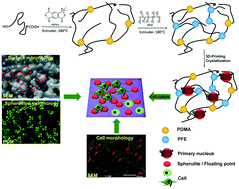Crystallization and biocompatibility enhancement of 3D-printed poly(l-lactide) vascular stents with long chain branching structures†
Abstract
A series of adjustable long chain branching poly(L-lactide)s (b-PLAs) was prepared by reactive processing of linear PLA using pyromellitic dianhydride (PMDA) and polyfunctional epoxy ether (PFE) as the branching agent and their vascular stents were fabricated via 3D-printing. Fourier-transform infrared (FTIR) spectroscopy and gel permeation chromatography (GPC) results indicated that the chain branching reaction occurs and the average molecular weight increases obviously after the chain branching reaction. Rheological tests on the b-PLAs demonstrated that they are composed of a symmetric- or asymmetric-star, or tree-like chain configuration. The volume fraction of the branching structure of the chains increased from 0.03 to 0.3 with increasing branching agent content. The effects of the branching structure on the melt crystallization behavior of b-PLAs were investigated by means of differential scanning calorimetry (DSC). The isothermal crystallization results showed that the half-time of crystallization (t1/2) of the samples decreased from 16.8 min for linear PLA to 2.3 min when the branching agent content was 2 wt% at 106 °C. Also, as observed from polarized optical microscopy experiments, the nucleation density of the b-PLAs significantly increased with increasing volume fraction of the branching structure because the enrichment of segments around the branching structure facilitated nucleation, thus the b-PLA samples have a higher probability to form a primary nucleus than linear PLA. Moreover, mechanical testing demonstrated that forming the branching structure enabled the effective modification of the mechanical properties of PLA. The microstructures with a smaller spherulite size and higher crystallinity of the b-PLAs improved their tensile strength and modulus from 45.7 MPa and 1.63 GPa to 77.2 MPa and 3.41 GPa, respectively. Furthermore, the radial force performance of the 3D printed b-PLA vascular stents was enhanced from 4.8 to 13.7 N by the branching structure of the chains. The CCK-8 assay results indicated that the osteoblast activity of b-PLA is higher than that of linear PLA, and the scanning electron microscopy (SEM) results also indicated that b-PLA was covered and flattened with a better attachment morphology for the osteoblasts than PLA. Therefore, the b-PLAs with a long chain branching structure could effectively facilitate cell growth, proliferation, and differentiation.



 Please wait while we load your content...
Please wait while we load your content...